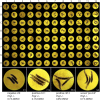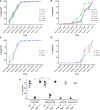Defects in the Neuroendocrine Axis Contribute to Global Development Delay in a Drosophila Model of NGLY1 Deficiency
- PMID: 29735526
- PMCID: PMC6027897
- DOI: 10.1534/g3.118.300578
Defects in the Neuroendocrine Axis Contribute to Global Development Delay in a Drosophila Model of NGLY1 Deficiency
Erratum in
-
CORRIGENDUM.G3 (Bethesda). 2019 Jan 9;9(1):315. doi: 10.1534/g3.118.200895. G3 (Bethesda). 2019. PMID: 30626722 Free PMC article. No abstract available.
Abstract
N-glycanase 1 (NGLY1) Deficiency is a rare monogenic multi-system disorder first described in 2014. NGLY1 is evolutionarily conserved in model organisms. Here we conducted a natural history study and chemical-modifier screen on the Drosophila melanogaster NGLY1 homolog, Pngl We generated a new fly model of NGLY1 Deficiency, engineered with a nonsense mutation in Pngl at codon 420 that results in a truncation of the C-terminal carbohydrate-binding PAW domain. Homozygous mutant animals exhibit global development delay, pupal lethality and small body size as adults. We developed a 96-well-plate, image-based, quantitative assay of Drosophila larval size for use in a screen of the 2,650-member Microsource Spectrum compound library of FDA approved drugs, bioactive tool compounds, and natural products. We found that the cholesterol-derived ecdysteroid molting hormone 20-hydroxyecdysone (20E) partially rescued the global developmental delay in mutant homozygotes. Targeted expression of a human NGLY1 transgene to tissues involved in ecdysteroidogenesis, e.g., prothoracic gland, also partially rescues global developmental delay in mutant homozygotes. Finally, the proteasome inhibitor bortezomib is a potent enhancer of global developmental delay in our fly model, evidence of a defective proteasome "bounce-back" response that is also observed in nematode and cellular models of NGLY1 Deficiency. Together, these results demonstrate the therapeutic relevance of a new fly model of NGLY1 Deficiency for drug discovery and gene modifier screens.
Keywords: Drosophila; N-glycanse 1; NGLY1; Pngl; disease model.
Copyright © 2018 Rodriguez et al.
Figures








References
-
- Bi Y., Might M., Vankayalapati H., Kuberan B., 2017. Repurposing of Proton Pump Inhibitors as first identified small molecule inhibitors of endo-β-N-acetylglucosaminidase (ENGase) for the treatment of NGLY1 deficiency, a rare genetic disease. Bioorg. Med. Chem. Lett. 27: 2962–2966. 10.1016/j.bmcl.2017.05.010 - DOI - PMC - PubMed
-
- Brand A. H., Perrimon N., 1993. Targeted gene expression as a means of altering cell fates and generating dominant phenotypes. Development 118: 401–415. - PubMed
Publication types
MeSH terms
Substances
Supplementary concepts
LinkOut - more resources
Full Text Sources
Other Literature Sources
Molecular Biology Databases
